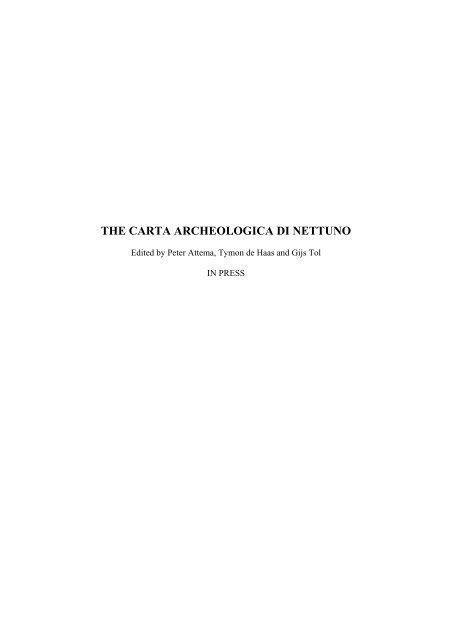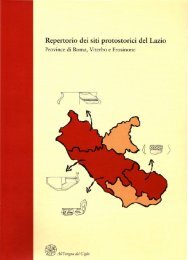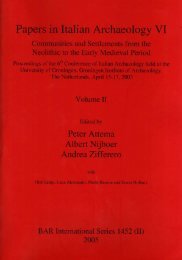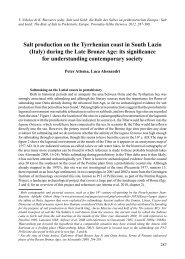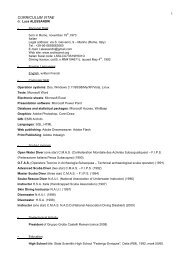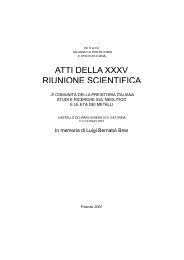THE CARTA ARCHEOLOGICA DI NETTUNO - Archeonet.Org
THE CARTA ARCHEOLOGICA DI NETTUNO - Archeonet.Org
THE CARTA ARCHEOLOGICA DI NETTUNO - Archeonet.Org
You also want an ePaper? Increase the reach of your titles
YUMPU automatically turns print PDFs into web optimized ePapers that Google loves.
<strong>THE</strong> <strong>CARTA</strong> <strong>ARCHEOLOGICA</strong> <strong>DI</strong> <strong>NETTUNO</strong><br />
Edited by Peter Attema, Tymon de Haas and Gijs Tol<br />
IN PRESS
6 BRONZE AGE<br />
Luca Alessandri<br />
MIDDLE BRONZE AGE<br />
When leaving out a not yet published ancient Bronze Age site in an area called ‘Stop 4’, 1<br />
the oldest protohistorical artefacts in the municipal territory of Nettuno date to the middle<br />
Bronze Age. Notably in the area of Campana, ceramic artefacts that can be attributed to<br />
the middle Bronze Age 1 and 2 have been collected at various locations. 2 The shards<br />
were for the first time noted by A. Liboni and are now kept in the Antiquarium of<br />
Nettuno. 3 Thereafter, survey campaigns of the GIA have allowed a better delineation of<br />
the area of dispersion of the ceramic fragments and the state they are in. 4 A catalogue of<br />
the most important fragments is included at the end of this chapter.<br />
The shards appear at the surface on the right bank of the Fosso del Quinto, a tributary of<br />
the Fosso di Loricina, and are found in various concentrations parallel to the course of<br />
this stream, over a distance of circa 1000 m Another isolated concentration of impasto<br />
shards that unfortunately lack any diagnostic features, has been recorded on the opposite<br />
side of the fosso, in the locality Piscina Cardillo. 5 A few ceramic fragments have also<br />
been identified along the beach south of the mouth of the Fosso Foglino, 6 while a heavily<br />
abraded handle that can be attributed to the full phase of the middle Bronze Age, was<br />
recorded near Torre Astura; unfortunately it is without a precise location. 7 Just outside<br />
the municipal territory, to the west, in the locality Cacamele, ceramic fragments that can<br />
be attributed to the middle Bronze Age 1 were found along both sides of the Fosso<br />
Tinozzi, formerly called the Fosso Cacamele.<br />
It seems therefore that the settlements of the first phases of the middle Bronze Age tend<br />
to be located along water courses; however, a study of the present author on the coastal<br />
sites of central south Italy between the rivers Tiber and Garigliano, has not revealed a<br />
statistically relevant correlation between river courses and protohistorical settlements (fig<br />
6.1). There is, though, a strong relation between the latter and natural springs; in fact the<br />
settlements of Cacamele, La Campana and Fosso Foglino are located in the immediate<br />
vicinity of sweet water springs (fig. 6.2). 8 The territory at one hour’s walking distance<br />
from each settlement consists foremost of sandy terrains, not very suited for an intensive<br />
type of agriculture; it stands therefore to reason that an important part of the subsistence<br />
strategy would have included hunting, fishing and gathering in the large forests that must<br />
still have characterized this part of the coast. The territory of Nettuno does not offer sites<br />
with a strategical potential of any importance, Cacamele, La Campana and Fosso Foglino<br />
are situated in open positions. However, this is congruent with the general tendency<br />
1 This site was discussed by A. Guidi on the XL Riunione Scientifica Preistoria e Protostoria; while this<br />
contribution is still in course of publication, the site has also been published in RSPL 2007, 225/226. This<br />
volume also describes a yet unublished site dating to the middle Bronze Age phase 1 and 2 in the locality<br />
San Giacomo (RSPL 2007: 221-224).<br />
2 See site cat. nrs. 15078, 15245, 15007, 15010, 15068 and 15248.<br />
3 First published in Alessandri 2007.<br />
4 Haas/Tol 2005.<br />
5 See site cat. nr. 15005.<br />
6 See site cat. nr. 15243; RSPL 2007, 218/219.<br />
7 See site cat. nr. 11202; Alessandri 2007.<br />
8 Alessandri 2007, 165-176.
found in all contemporary coastal sites: it is the case, for instance, at Spiaggio San<br />
Lorenzo to the north, Colle Parito, Caratterino and Borgo Ermada to the south (fig. 6.3). 9<br />
No sites dating to the advanced phase of the middle Bronze Age are known in the<br />
territory of Nettuno; this is in agreement with a general thinning out of the archaeological<br />
evidence in this phase in all of central south Lazio (fig. 6.4).<br />
RECENT BRONZE AGE<br />
There are, however, various sites for the successive phase of the recent Bronze Age.<br />
These have been recorded in the stretch of beach along the Poligono Militare (fig. 6.5). In<br />
the locality Saracca a number of basins filled with depurated clay have been exposed by<br />
marine and meteoric erosion. 10 These were found below a structure dating to the Roman<br />
period and near an imposing natural deposit of clay (fig. 6.6); 11 further north, an axe<br />
datable to the same phase has been found in the locality Le Grugnole. Immediately<br />
outside the municipal territory there are the sites of Colle Rotondo, situated more inland,<br />
and in this phase known only through the presence of the necropolis of Cavallo Morto,<br />
and Casale Nuovo, to the east. 12<br />
FINAL BRONZE AGE<br />
In the opinion of the author, the archaeological evidence at the site of La Saracca can<br />
only be read taking account of the archaeological evidence of the immediately following<br />
period. In the final Bronze Age we witness, in the same stretch of beach in which<br />
Saracca is also located, the birth of two very specific sites, Le Grottacce and Pelliccione,<br />
in which settlement debris stricto sensu are almost completely absent (fig. 6.7). 13 By far<br />
the largest part of the ceramic fragments collected in the excavation of Pelliccione in fact<br />
belong to jars (olle) or large containers; the small quantity of pottery that could be<br />
recovered from the exposure at Le Grottacce points at a similar situation here. These sites<br />
are interpreted as salt extraction sites of the atelier de briquetage type. 14 The jars would<br />
have been used to boil sea water - whether treated or not beforehand - to extract salt from<br />
it. 15 In this way a very firm substance is formed in the jar, for the extraction of which it is<br />
necessary to break the vessel; this explains the enormous accumulation of ceramic<br />
fragments that is characteristic of these sites.<br />
It is difficult, at this point, not to consider the settlement of Saracca, the clay basins of<br />
which are presumably connected with the production of pottery, as in one way or another<br />
connected with this process. It is very probable that the jars were produced on the spot, in<br />
series, to be used right away. Both the abundant presence of clay along the coast as well<br />
as the presence of numerous sweet water springs nearby, have probably been key factors<br />
in the choice to locate this sort of sites in this area. It must be kept in mind, however, that<br />
just north of Pelliccione and in the localities of Finocchierelle, La Banca and Bottego<br />
9 For Spiagge S. Lorenzo: Guidi 1980; Morandini 1999; for a general framework of the Grotta Nuova<br />
pottery, Cocchi Genick 2002: 47; for Colle Parito: Alessandri 2007; for Caterattino: Guidi 1981; for a<br />
general framework, Cocchi Genick 1995; for Borgo Ermada: Pascucci 1996a; Holstrom et al. 2004.<br />
10 See site cat. nr. 11209; RSPL 2007, 224/225.<br />
11 See chapter 1.<br />
12 For Cavallo Morto and Colle Rotondo, see Quilici/Quilici Gigli 1984b; Angle et al. 2004; for Casale<br />
Nuovo, see Gianni et al. 1984; Angle et al. 1992, 1993; Angle 1996.<br />
13 For Le Grottacce (site cat. nr. 11215), see Piccarreta 1977, site 15; Attema et al. 2003a; for Pelliccione<br />
(site cat. nr. 11213), see Piccarreta 1977, site 13; Attema et al. 2003a; Nijboer et al. 2006; RSPL 2007, 219-<br />
221.<br />
14 Pacciarelli 1999, 2000; Nijboer et al. 2006.<br />
15 Daire 1994.
other exposures have been found with impasto pottery, very similar to that found at<br />
Pelliccione. 16 Unfortunately, repeated surveys have not yielded diagnostic fragments, but<br />
also in these cases the ceramics, judging from their clay, thickness and dimensions,<br />
exclusively appear to belong to large containers.<br />
The enormous quantity of fragments found in the excavation of Pelliccione, but also<br />
noted at other sites, tells us much about the considerable quantity of goods that must have<br />
been produced here. Moreover, it is clear that the production must have well exceeded<br />
that needed by the local community, and that the surplus generated in this way must have<br />
been part of a well-structured exchange network. Evidence of this are the Mycenean and<br />
Italo-Mycenean fragments found at Casale Nuovo and Pelliccione that, far from<br />
indicating direct contacts between Mycenean and local peoples, point to the organic<br />
participation of these sites in a fairly wide circuit of exchange between communities. A<br />
final site to be mentioned is Bosco di Nettuno, located more into the interior. The ceramic<br />
assemblage of this site consists exclusively of jars (ollae) and large ceramic containers.<br />
16 For the exposure north of Pelliccione, see site cat. nr. 15124; for Finocchierelle, see site cat. nr. 11216;<br />
for La Banca, see site cat. nr. 11206; for Bottego, see site cat. nr. 15122.
Fig. 6.1. Distances between settlements and their nearest stream; the comparison between<br />
the number of sites observed and the number of sites expected indicates a random<br />
distribution (after Alessandri 2007).<br />
Fig. 6.2. The area within an hours walk from the settlements of Cacamele, La Campana<br />
(site 15010) and Fosso Foglino (site 15243); the landscape is classified by its suitability<br />
for agriculture, with the first class representing the best suitability (for a more detailed<br />
definition, see Alessandri 2007; springs are discussed by Ventriglia 1990).
Fig. 6.3. Coastal sites dated in the earliest phase of the middle Bronze Age (municipality<br />
of Nettuno is highlighted in darker grey).<br />
Fig. 6.4. Abandoned sites, new foundations and sites that show continuity from the<br />
previous period (BA: early Bronze Age; BM: middle Bronze Age; BR: recent Bronze<br />
Age; BF: final Bronze Age; RMCA: early Iron Age; from Alessandri 2007).
Fig. 6.5. Coastal sites dated in the recent Bronze Age (municipality of Nettuno is<br />
highlighted in darker grey); the exact provenance of the axe from Le Grugnole (site<br />
15244) is unclear and thus not indicated on the map.<br />
Fig. 6.6. The section of site La Saracca (site 11209); stones are indicated in white,<br />
ceramic fragments in grey.
Fig. 6.7. Coastal sites dated in the final Bronze Age (municipality of Nettuno is<br />
highlighted in darker grey); Finocchierelle (site 11216) and La Banca (site 11206) are not<br />
dated with certainty.
CERAMICS FROM LA CAMPANA (MIDDLE BRONZE AGE 1-2, MIDDLE<br />
BRONZE AGE 3)<br />
Below, the diagnostic fragments from several locations in the Campana area and<br />
elsewhere in the Nettuno area that have been collected during various visits by A.<br />
Liboni and the GIA are catalogued. Diagnostic pieces without chronological value have<br />
not been included in this catalogue.<br />
Site 15078 (“La Campana, Pineta bassa”)<br />
Besides several impasto wall fragments:<br />
1.<br />
Rim fragment of a bowl, surface 5YR 4/2 dark reddish<br />
grey, diameter unknown.<br />
Site 15068 (“Fosso del Quinto, Campana, vicino Sughereto”)<br />
Besides several impasto wall fragments and an Archaic dolium fragment:<br />
2.<br />
Rim fragment of a deep bowl or carenated cup with<br />
maximum diameter at rim, surface 5YR 4/2 dark<br />
reddish grey, rounded breaks, diameter unknown,<br />
exact inclination unclear.<br />
3.<br />
Rim fragment, probably of a bowl a bordo rientrante<br />
with bugno on maximum diameter and possibly<br />
handle attachment or second bugno, surface 5YR 4/4<br />
reddish brown, rounded breaks, diameter unknown.<br />
4.<br />
Facetted spindle whorl, surface 5YR 4/4 reddish<br />
brown.<br />
Site 15078 (“La Campana, vicino Pinetella bassa”)<br />
Besides several impasto wall fragments and later ceramics:<br />
5.<br />
Rim fragment of a troncoconical bowl with flattened<br />
lip, surface 5YR 4/2 dark reddish grey, sharp breaks,<br />
diameter unknown.<br />
Not from a specific site, generically from “La Campana”<br />
6.<br />
Wall fragment of a deep bowl a carena ispessita with<br />
maximum diameter at rim, surface 2.5YR 3/1 dark<br />
reddish grey, rounded breaks.<br />
7.<br />
Rim fragment of a bowl a bordo rientrante, surface<br />
2.5YR 3/1 dark reddish grey, rounded breaks.<br />
Site 15245 (“La Campana”)<br />
8.
Rim fragment of a carenated deep bowl with equal<br />
diameter at mouth and shoulder, out curving rim,<br />
surface 5YR 4/2 dark reddish grey, rounded breaks.<br />
9.<br />
Rim fragment of a carenated deep bowl with<br />
maximum diameter at rim, above carena slightly in<br />
curving, out turning rim with internal angle, surface<br />
5YR 4/4 reddish brown, rounded breaks.<br />
10.<br />
Rim fragment of a jar with out curving rim and<br />
notched decoration on lip, surface 5YR 4/4 reddish<br />
brown, rounded breaks.<br />
Site 15007 (“La Campana parte frumento vicino alla strada”)<br />
11.<br />
Rim fragment of a carenated deep bowl with equal<br />
diameter at mouth and shoulder, carena almost directly<br />
below rim, surface 5YR 4/2 dark reddish grey,<br />
rounded breaks.<br />
Site 15248 (“La Campana, sughereto, dalla parte opposta al frumento”)<br />
12.<br />
Rim fragment of a carenated deep bowl, wall almost<br />
vertical above carena, slightly out curving rim, surface<br />
5YR 4/2 dark reddish grey, rounded breaks.<br />
13.<br />
Fragment of a band handle with pointed margins and<br />
outer ends lightly folded outwards, surface 5YR 4/2<br />
dark reddish grey, rounded breaks.<br />
14.<br />
Rim fragment of a bowl a bordo rientrante with<br />
straight wall and pointed lip, surface 2.5YR 3/0 very<br />
dark grey, rounded breaks, exact inclination unclear.<br />
15.<br />
Rim fragment of an ovoidal jar with out turning rim<br />
and notched decoration on lip, surface 5YR 4/4<br />
reddish brown, rounded breaks.<br />
16.<br />
Rim fragment of a troncoconical jar with strongly out<br />
turning rim, surface 2.5YR 3/0 very dark grey,<br />
rounded breaks.<br />
17.<br />
Discoidal spindle whorl, surface 5YR 4/4 reddish<br />
brown, upper side abraded.<br />
Site 15010 (“Casale la Campana”)<br />
18.<br />
Fragment of an elevated band handle with parallel<br />
sides and upper part expanding into a T, surface 5YR<br />
4/4 reddish brown, very rounded breaks.<br />
19.<br />
Fragment of an elevated band handle with pointed<br />
outer ends, surface 2.5YR 3/0 very dark grey, worn<br />
fractures.<br />
20.<br />
Fragment of an elevated band handle with pointed<br />
outer ends, surface 2.5YR 3/0 very dark grey, rounded<br />
breaks<br />
21.<br />
Fragment of a vertical elevated band handle, surface<br />
2.5YR 3/0 very dark grey, rounded breaks.<br />
22.<br />
Band handle fragment of a cup, possibly with a<br />
“tongue shaped” elevation, surface 2.5YR 3/0 very<br />
dark grey, rounded breaks.<br />
23.<br />
Rim fragment of a carenated deep bowl with<br />
maximum diameter at the carena, short neck above<br />
carena, outcurvnig and then incurving rim,<br />
troncoconical deep body, surface 5YR 4/4 reddish<br />
brown, reasonably clear breaks<br />
24.<br />
Rim fragment of a carenated deep bowl with<br />
maximum diameter at the carena, short neck above<br />
carena, troncoconical deep body, ext 5YR 4/4 reddish<br />
brown, int 2.5YR 3/0 very dark grey, rounded breaks.<br />
25.<br />
Rim fragment of a small carenated cup, maximum<br />
diameter at the carena, surface 2.5YR 3/0 very dark<br />
grey, rounded breaks.<br />
26.<br />
Rim fragment of a carenated deep bowl with equal<br />
diameter at rim and carena, out curving rim, ext 5YR
4/4 reddish brown, int 2.5YR 3/0 very dark grey,<br />
partly eroded, rounded breaks.<br />
27.<br />
Rim fragment of a carenated cup with equal diameter<br />
at carena, carena almost directly below rim, surface<br />
2.5YR 3/0 very dark grey, rounded breaks.<br />
28.<br />
Rim fragment of a troncocoidal bowl with strongly out<br />
curving rim, surface 5YR 4/4 reddish brown, int<br />
eroded, rounded breaks.<br />
29.<br />
Rim fragment of a globular deep bowl with strongly<br />
out curving rim, surface 2.5YR 3/0 very dark grey,<br />
eroded, rounded breaks.
<strong>DI</strong>SCUSSION<br />
The carenated ciotola nr. 2, although its inclination is uncertain, may be similar to several<br />
examples from Valle Felici, 17 a context dated to the initial phase of the middle Bronze<br />
Age. 18 This site also yields a parallel for ciotola nr. 6; 19 Ciotola nr. 9 is similar to typ 179<br />
in Aspetti, dated to the middle Bronze Age 2A. 20<br />
Rim fragment nr. 10 can also be ascribed to a type from Aspetti, 21 belonging to the Grotta Nuova facies<br />
and the southern protoappennine facies, dated to the second phase of the middle Bronze Age. Ciotole nrs. 8<br />
and 11 appear to be older; they can be attributed to type 359, 22 common in the Abruzzo and in north<br />
Campanian contexts of the first phase off the middle Bronze Age. Handle fragment nr. 13 is similar to an<br />
example from Vivara, Punta d’Alaca, 23 dated to the full phase of the middle Bronze Age; the carenated<br />
ciotole nrs. 12, 26 and 24 can be attributed to the same phase, to type 205B of the Grotta Nuova facies. 24<br />
Scodella nr. 14 is similar to type 37B in the same work 25 and is common in pre-appennine and appennine<br />
contexts; the ovoidal olla nr. 15 can be ascribed to type 411A. 26 Fragment nr. 18 belongs to type 477 27 and<br />
is considered common in the Grotta Nuova and the protoappennine facies, dating to the first phase of the<br />
middle Bronze Age; to that same phase fragments nrs. 19 and 20, both of type 500B 28 , should be ascribed.<br />
The ansa con sopraelevazione, probabilmente terminante a punta dates to the middle Bronze Age; this type<br />
finds a parallel in an example from Ponte S. Pietro Valle, trench B, 29 a context yielding fragments of the<br />
initial phase of the middle Bronze Age and the recent Bronze Age, 30 but also in a fragment from Lariano. 31<br />
Fragment nr. 26 has a clear parallel in the Villaggio delle Macine 32 , dated to middle<br />
Bronze Age 1B 33 ; other 1 st phase fragments include nr. 27, similar to an example from<br />
Candalla, Riparo della Roberta, layer c, 34 and fragment nr. 28, similar to a fragment from<br />
the Grotta dell’Orso at Sarteano. 35 Fragment 29 may indicate later frequentation; this<br />
fragment has a parallel from Tor San Giovanni, dated to the middle Bronze Age phase<br />
3. 36<br />
17 Bermond Montanari 1992, fig. 1, nrs. 25 and 27.<br />
18 Cocchi Genick 2002, 36, site 12; this complex is dated to the middle Bronze Age 1A.<br />
19 Bermond Montanari 1992, fig. 1, nr. 28; for the date see note 14 above.<br />
20 AA.VV. 1995, 122.<br />
21 AA.VV. 1995, 253, type 43.<br />
22 AA.VV. 1995, 220/221.<br />
23 Sector E, southeastern settlement area; see Damiani et al. 1984, fig. 4C, n. 3. Cocchi Genick considers<br />
this type to be a variant of type 496, dated to the second phase of the middle Bronze Age and common in<br />
the Grotta Nuova facies and in Tyrrhenean, Adriatico and Alto Jonio-contexts of the protoappennine facies.<br />
24 AA.VV. 1995, 138.<br />
25 AA.VV. 1995, 46.<br />
26 AA.VV. 1995, 243.<br />
27 AA.VV. 1995, 281.<br />
28 AA.VV. 1995, 294.<br />
29 Negroni Catacchio 1981, fig. 105, nr. 18.<br />
30 Cocchi Genick 2002, 41 (MBA2A).<br />
31 Guidi 1981, fig. 5, nr. 5.<br />
32 Chiarucci 1985, fig. 1, nr. 2.<br />
33 Cocchi Genick 2001, 207, type 279.<br />
34 Cocchi Genick 1984, fig. 1, nr. 1. In AA.VV 1995, 132, the type is considered to be a variant of type<br />
195, common in the Grotta Nuova facies and the protoappennine, dated to the first phase of the middle<br />
Bronze Age.<br />
35 Cremonesi 1968, fig. 12, n. 10. In AA.VV 1995, 178, the type is considered to be a variant of type 277,<br />
common in the Grotta Nuova facies and the Adriatic and Tyrrhenian protoappennine groups, dated to the<br />
first phase of the middle Bronze Age.<br />
36 Dottarelli et al. 1984, fig. 4, nr. 3.
BRONZE AGE CERAMICS FROM O<strong>THE</strong>R LOCATIONS IN <strong>THE</strong> <strong>NETTUNO</strong> AREA<br />
Site 15243 (Fosso Foglino)<br />
1.<br />
Rim fragment, possibly of a rounded bowl with<br />
vertical band handle or perforated lug with probably a<br />
tongue shaped extension attached to the lip, surface<br />
2.5YR 3/0 very dark grey, abraded, rather rounded<br />
breaks.<br />
2.<br />
Wall fragment of a closed form with a broad vertical<br />
band handle, surface 5YR 3/4 dark reddish brown,<br />
rounded breaks.<br />
3.<br />
Rim fragment of a jar, very likely of ovoid shape, with<br />
a short small neck, slightly outturning, and with<br />
rounded lip, surface 5YR 3/4 dark reddish brown,<br />
rounded breaks.<br />
4.<br />
Rim fragment of a jar, very likely of globular shape,<br />
with a vertical neck and rounded lip, surface 2.5YR<br />
4/6 red, rounded breaks<br />
5.<br />
Rim fragment of a jar, very likely of ovoid shape, with<br />
a vertical neck and rounded lip, surface 2.5YR 4/6 red,<br />
rounded breaks, with a slightly outturning rim and<br />
rounded lip, surface 5YR 5/6 yellowish red, rounded<br />
breaks.<br />
<strong>DI</strong>SCUSSION<br />
The fragment of the bowl (scodella) nr. 1 is not unlike type 18, variant A in the typology<br />
of D. Cocchi Genick. 37 This type appears in the context of the protoappenine facies in<br />
ceramic groups from the Abruzzi and north Campania and is assigned to phase 1 of the<br />
Middle Bronze Age. Apart from the fragment of a jar (olla), nr. 3, two other impasto<br />
fragments were collected on the beach at ca 100 m northeast of the site. The very worn<br />
fractures, and the fact that no archaeological sites exist in the surroundings of the findspot<br />
except for Fosso Foglino, would indicate that these fragments indeed come from the latter<br />
site; the forms, although hardly diagnostic, are compatible with the dating of the bowl<br />
(scodella).<br />
37 AA.VV. 1995, p. 34
Site 11209 (Saracca)<br />
1.<br />
Rim fragment of a cup or carenated deep bowl with<br />
rounded lip, wall lightly ingoing, elevated vertical<br />
band handle (upper part missing) attached to the part<br />
of the wall immediately above the carena and to the<br />
interior of the rim, surface 2.5YR 4/4 reddish brown,<br />
fairly sharp breaks. Surface 2.5YR 4/4 reddish brown,<br />
rather sharp breaks.<br />
2.<br />
Rim fragment of a small barrel formed jar with<br />
continuous rim with internal angle and obliquely cut<br />
lip, horizontal notched cord applied below the rim.<br />
Surface 7.5YR 3/4 dark brown, rather rolled breaks<br />
3.<br />
Rim fragment of probably a collared vase with<br />
troncoconical wall and slightly outturning rim with an<br />
internal angle, surface 2.5YR 4/6 red, fairly sharp<br />
breaks.<br />
4.<br />
Rim fragment of a troncoconical bowl with straight<br />
wall with a distinct rim and rounded lip with internal<br />
angle, surface 2.5YR 3/6 dark red, fairly sharp breaks<br />
5.<br />
Rim fragment with flattened lip of a troncoconical<br />
vase, surface 5YR 4/3 reddish brown, fairly sharp<br />
breaks.<br />
6.<br />
Rim fragment of with distinct rounded lip, surface<br />
5YR 4/3 reddish brown, fairly sharp breaks.<br />
7.<br />
Rim fragment with tapering lip of a troncoconical<br />
vase, surface 2.5YR 4/4 reddish brown<br />
8.<br />
Fragment of an outturning rim with rounded lip,<br />
surface 5YR 4/3 reddish brown, fairly sharp breaks.<br />
9.<br />
Fragment of an outturning rim with tapering lip,<br />
surface 5YR 4/3 reddish brown, fairly rounded breaks<br />
10.<br />
Fragment of outturning rim with lip obliquely cut<br />
towards exterior, surface 7.5YR 3/2, dark brown,<br />
fairly rounded breaks.<br />
<strong>DI</strong>SCUSSION<br />
Among the fragments collected at the site, the bowl (ciotola), nr. 1, is characterized by a<br />
probably straight cylindrical upper part, which is not unlike the ones seen in the examples<br />
from S. Giovenale, Area A, settore Sud, strati 11 and 15, a context that can be dated to<br />
the oldest phase of the Recent Bronze Age. 38<br />
Similarly, the barrel shaped jar (olla a botte) nr. 2 matches examples from Recent<br />
Bronze Age contexts; a similar specimen is known from a Recent Bronze Age context at<br />
S. Giovenale (area B, trench AP 58:1, test pit B, strata 8-7). 39<br />
Finally, the truncated conical bowl (scodella) nr. 4 resembles a specimen from Broglio di<br />
Trebisacce (sett. D east, livello S, riq H) that can be classified as Giardino’s type 10. It<br />
can be dated to the Recent Bronze Age. 40<br />
38 Damiani 1991, p. 24<br />
39 Berggren, Berggren 1981, p. 13<br />
40 Giardino 1994, p. 220
Site 11206 (La Banca)<br />
1.<br />
Fragment of a barrel shaped jar with almost distinct<br />
rim, rounded lip and indication of internal angle.<br />
Surface 5YR 3/2 dark reddish brown, rather rolled<br />
breaks<br />
<strong>DI</strong>SCUSSION<br />
The fragment of the jar (olla) nr. 1 was found ca 250 m north of the site of La Banca,<br />
near the crescent moon shaped fish basin of site 11207. Considering the distance, it is<br />
doubtful whether the sherd originally belonged to this site. The fragment, being without<br />
context, cannot easily be interpreted. However, the type of impasto is quite similar to that<br />
of the Final Bronze Age sites Le Grottacce (site 11215) and Pellicione (site 11213).<br />
Site 15005 (Piscina Cardillo)<br />
1.<br />
Fragment of a bowl with a slightly incurving rim, a<br />
bugna immediately below the rim, surface 7.5YR 3/2,<br />
dark brown, rounded breaks<br />
<strong>DI</strong>SCUSSION<br />
This bowl (nr. 1), is rather common and its date is therefore imprecise; anyhow, it can be<br />
attributed to the Middle Bronze Age.<br />
Site 15244 (Le Grugnole)<br />
1.<br />
Winged axe<br />
<strong>DI</strong>SCUSSION<br />
This axe can on account of its wings that are converging towards the lower end, its<br />
distinct end and slightly pronounced shoulder, be dated to the Recent Bronze Age.
Site 15246 (Bosco di Nettuno)<br />
1.<br />
Frammento di olla ovoide con orlo svasato, cordone<br />
digitato orizzontale, superficie 2.5YR 4/6 red,<br />
fratture abbastanza nette<br />
2.<br />
Frammento di olla ovoide con orlo in continuità,<br />
superficie molto abrasa, colore 5 YR 4/3 reddish<br />
brown, fratture fluitate e concrezioni da permanenza<br />
in acqua (impasto assai dissimile dal restante<br />
materiale, intruso)<br />
3.<br />
Frammento di orlo svasato a spigolo interno di<br />
probabile olla, superficie 2.5YR 4/6 red, fratture<br />
abbastanza fluitate<br />
4.<br />
Frammento di olla globulare a breve colletto<br />
verticale, spigolo interno, labbro appiattito,<br />
superficie 2 3/10B dark bluish grey, fratture fluitate,<br />
diametro non ricostruibile, inclinazione dubbia<br />
<strong>DI</strong>SCUSSION<br />
The fragment of the ovoid jar (olla) nr. 1 has parallels in Fossa della Cavatella in a<br />
mixed context with a predominance of sherds dating to the Final Bronze Age/Early<br />
Iron Age. 41 Also the jar (olla) nr. 3 can be assigned to that period, while the globular<br />
jar (olla) nr. 4 has a close parallel in a stratigraphical unit at S. Giovenale, dated to the<br />
Final Bronze Age. 42<br />
The ovoid jar (olla) with the continuous rim, nr.2, is probably older, and apparently is<br />
a later intrusion: the state of conservation indicates clearly a prolonged immersion in<br />
water, a condition which lacks in the immediate neighborhood of the site.<br />
41 Pascucci 1996b, fig. 2, n. 13<br />
42 Berggren, Berggren 1981, “test pit M-N, stratum 2”, tav. 26, n. 64<br />
20
Site 11202 (Torre Astura)<br />
Reported as coming from “Torre Astura”<br />
1.<br />
Fragment of a handle with an oval perforation, very<br />
rounded breaks. Completely abrased surface, surface<br />
7.5YR 3/2 dark brown, probably from the seafloor,<br />
fairly sharp breaks<br />
Reported as coming from “Torre Astura”, left side of entrance<br />
2.<br />
Fragment of an ovoid jar with outturning and<br />
incurving rim, a horizontal notched cord applied<br />
immediately below the rim, surface 2.5YR 4/8 red,<br />
rounded breaks, probably from the sea floor<br />
3.<br />
Fragment of probably a jar with outturning rim with<br />
internal angle and tapering lip, surface 2.5YR 4/4<br />
reddish brown, fairly sharp breaks<br />
<strong>DI</strong>SCUSSION<br />
The oldest Bronze Age fragment, although in a bad state of conservation, is represented<br />
by the lug (nr. 1), which resembles a specimen from Gola del Sentino, Grotta dei<br />
Baffoni. 43 dated to the Middle Bronze Age 2A. 44 Since the sherd has very rounded<br />
fractures and completely worn surfaces, it may have originated from elsewhere along the<br />
coast.<br />
The fragment of the ovoid jar (olla) nr. 2 resembles three specimens from Satricum found<br />
in late orientalizing contexts at its earliest. 45 Fragment nr. 3 likewise has a parallel at<br />
Satricum, but in an early orientalizing stratum. 46<br />
43 Radmilli 1956, fig. 3, n. 4<br />
44 Cocchi Genick 2001, tipo 498B, p. 355<br />
45 Maaskant Kleibrink M. 1992a, n. 2692, 2710 e 2720, stratum IIC mixed with IIB: outside building G<br />
46<br />
Maaskant Kleibrink M. 1992a, n. 2469, stratum IIA: the pottery found in part of the area of female<br />
activity of hut feature VII<br />
22
BIBLIOGRAPHY<br />
AA. VV. 1995, Aspetti culturali della media età del bronzo nell'Italia centromeridionale,<br />
Firenze.<br />
Alessandri, L. 2007, L'occupazione costiera protostorica del Lazio centromeridionale,<br />
BAR International Series 1592, Oxford.<br />
Angle, M. 1996, Casale Nuovo, in C. Belardelli/P. Pascucci (eds.), Repertorio dei siti<br />
protostorici del Lazio - provincie di Rieti e Latina, Roma, 61-63.<br />
Angle, M./C. Caneva/A. Conti/R. Dottarelli/A. Gianni/C. Giardino/C. Persiani 1992,<br />
Casale Nuovo (LT) e la tarda eta del Bronzo nel Lazio meridionale, in Atti del III<br />
convegno di studi, un millennio di relazioni fra la Sardegna e i paesi del Mediterraneo,<br />
Cagliari, 265-303.<br />
Angle, M./A. Conti/R. Dottarelli/A. Gianni/C. Persiani/L. Vagnetti/R. Jones/L. Costantini<br />
1993, Prime testimonianze micenee nel Latium Vetus. PP CCLXX, 190-217.<br />
Angle, M./F. Di Gennaro/A. Guidi/S. Tusa 2004, La necropoli ad incinerazione di<br />
Cavallo Morto (Anzio, Roma), in Atti del Convegno L'età del Bronzo recente in Italia,<br />
Lido di Camaiore, 26-29.10.2000, 125-138.<br />
Attema, P./T. de Haas/A. Nijboer 2003a, The Astura project, interim report of the 2001,<br />
and 2002, campaigns of the Groningen Institute of Archaeology along the coast between<br />
Nettuno and Torre Astura (Lazio, Italy), BABesch 78, 107-140.<br />
Berggren, E./K. Berggren 1981, Excavations in Area B, 1957-1960, in San Giovenale II,<br />
2.<br />
Bermond Montanari, G. 1992, L'insediamento di Valle Felici presso Cervia e la media età<br />
del Bronzo in Romagna, Rassegna di Archeologia X, 375-384.<br />
Chiarucci, P. 1985, Contributo sulla topografia dell'antica Antium, Documenta Albana<br />
VII, 17-32.<br />
Cocchi Genick, D. 1984, L'insediamento dell'età del Bronzo di Candalla (Camaiore,<br />
Lucca), Rassegna di Archeologia IV, 105-148.<br />
Cocchi Genick, D. 1995, Aspetti culturali della media età del bronzo nell'Italia<br />
centromeridionale, Firenze.<br />
Cocchi Genick, D. 2001, Classificazione tipologica e processi storici. Le ceramiche della<br />
facies di Grotta Nuova, Viareggio.<br />
Cocchi Genick, D. 2002, Grotta Nuova: la prima unità culturale attorno all'Etruria<br />
protostorica, Viareggio.<br />
Cremonesi, L. 1968, La grotta dell'Orso di Sarteano. I livelli dell'eta dei Metalli, Origini<br />
II, 247-329.<br />
24
Daire, M. 1994, Le sel gaulois. Bouilleurs de sel et ateliers de briquetage armoricains à<br />
l'Age du Fer, Saint Malo.<br />
Damiani, I. 1991, Aspetti ceramici dell'età del Bronzo recente in Italia peninsulare e nelle<br />
isole Eolie: la facies subappenninica a trent'anni dalla sua definizione, DialA III-IX, 5-33.<br />
Dottarelli, R./H. Shirazi/L. Re/S. Vitagliano 1984, Progetto di ricognizione sistematica<br />
nel territorio di Roma. Ricognizioni di superficie F. 10S, in Bietti Sestieri, A. (ed.),<br />
Preistoria e protostoria nel territorio di Roma, Roma, 14-24.<br />
Gianni, A./G. Ruffo/M. Ruffo 1984, Lettera di segnalazione alla Soprintendenza<br />
Archeologica per il Lazio del 13.9.84.<br />
Giardino, C. 1994, I materiali dell'età del Bronzo recente, in R. Peroni/F.Trucco(eds.),<br />
Enotri e Micenei nella Sibaritide I. Broglio di Trebisacce, Taranto, 185-264.<br />
Guidi, A. 1980, Rinvenimenti preistorici nel territorio della soprintendenza del Lazio,<br />
Archeologia Laziale 3, 38-42.<br />
Guidi, A. 1981, Nuovi rinvenimenti in siti del passaggio alla media età del Bronzo,<br />
Archeologia Laziale IV, 47-55.<br />
Haas, T. de/G. Tol 2005, Survey in Campana, gemeente Nettuno (Italië), Paleoaktueel<br />
16, 77-83.<br />
Holstrom, S./A. Voorrips/H. Kamermans 2004, The Agro Pontino Archaeological Survey<br />
[cdRom], Leiden.<br />
Maaskant Kleibrink, M. 1992a, Settlement excavations at Borgo le Ferriere <br />
II the campaigns 1983, 1985, and 1987, Groningen.<br />
Morandini, A. 1999, Gli insediamenti costieri in età protostorica nel Lazio meridionale,<br />
Latium XVI, 5-47.<br />
Negroni Catacchio, N. 1981, Sorgenti della Nova. Una comunità protostorica e il suo<br />
territorio nell'Etruria Meridionale, Roma.<br />
Nijboer, A./P. Attema/G. Van Oortmerssen 2006, Ceramics from a late Bronze Age<br />
saltern on the coast near Nettuno (Rome, Italy), Palaeohistoria 47/48 [2005-2006], 141-<br />
205.<br />
Pacciarelli, M. 1999, Le origini di Vulci e il suo entroterra, in Atti del Convegno Ferrante<br />
Rittatore Vonwiller e la Maremma, 1936-1976, Ischia di Castro, 4-5.4.1998, 55-67.<br />
Pacciarelli, M. 2000, Dal Villaggio alla Città, La svolta protourbana del 1000, a.C<br />
nell'Italia tirrenica, Firenze.<br />
Pascucci, P. 1996a, Borgo Ermada, in C. Belardelli/P. Pascucci (eds.), Repertorio dei siti<br />
protostorici del Lazio - provincie di Rieti e Latina, Roma, 68-69.<br />
Pascucci, P. 1996b, Fosso della Cavatella, in C. Belardelli/P. Pascucci (eds.), Repertorio<br />
dei siti protostorici del Lazio - provincie di Rieti e Latina, Roma, 65-67.<br />
25
Piccarreta, F. 1977, Astura, Firenze.<br />
Quilici, L./S. Quilici-Gigli 1984b, Longula e Polusca, Archeologia Laziale VI, 107-132.<br />
Radmili, A. 1956, Ricerche intorno alla Gola del Sentino. III. Gli scavi nella Grotta dei<br />
Baffoni, Bullettino di Paletnologia Italiana LXV, 523-533.<br />
RSPL 2007, Repertorio dei siti protostorici del Lazio province di Roma, Viterbo e<br />
Frosinone, Firenze.<br />
26


